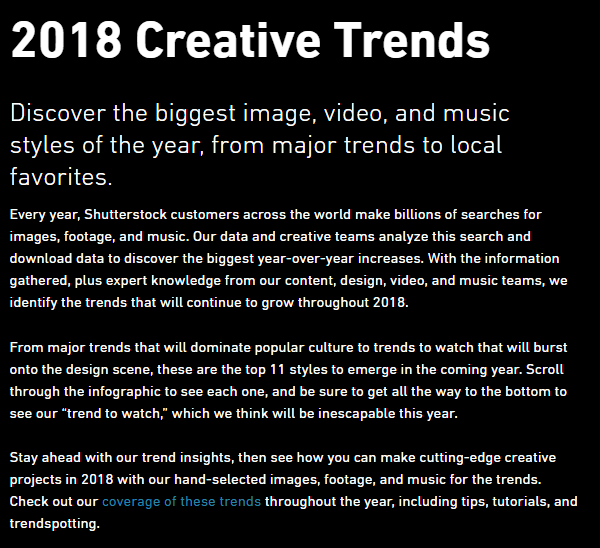Ecommerce Sales Through Content Marketing: 4 Examples
By Rodney Laws | Content

Content marketing and ecommerce go hand-in-hand.
Traditional sales strategies such as paid ads only go so far when it comes to convincing your customers to part with their hard-earned cash. Ad-savvy consumers are numb to the hard sell.
But content marketing overcomes this obstacle. It flies under the radar, a subtle product ad disguised as entertaining, informative, or useful content. You can introduce new customers to your brand in a way that feels natural and organic — and it works.
But creating the right kind of content that customers will love can be tricky. So instead of dithering over your content marketing, why not take some inspiration from the best? Read on for four examples of ecommerce content marketing that will inspire you today.
User-generated content is a quick-win for online store owners in a pinch. With an estimated 2.77 billion people worldwide on social media, there’s no shortage of UGC for ecommerce businesses to use in their content marketing strategy.
UGC is more than just an easy way to fill your editorial calendar. It’s a powerful form of content marketing that builds your customer community, showing shoppers that they matter to your brand to keep them returning time and again.
And for an example of UGC done right, one need look no further than luxury fashion brand, Burberry.
Luxury brands have traditionally been slow on the uptake when it comes to social media. But in 2009, Burberry took the plunge and launched its Art of the Trench campaign. The brand created a dedicated microsite on which it could display real customers showing off their Burberry trench coats.

Image Burberry
The campaign transformed its customers into pseudo-models for Burberry, giving some love to its consumer base while marketing its own products at the same time. What really took this campaign further though was the addition of links to Burberry product pages, so inspired customers could buy the same coat themselves with just a few clicks.
This is UGC done right. People-powered and product-pushing, the Art of the Trench campaign helped grow Burberry considerably online.
In the year following the campaign’s launch, the brand’s Facebook followers grew to more than a million, the highest in the industry at the time. Online year-on-year sales increased by 50%, and visitors to the Burberry website hit 7.5 million from 150 countries worldwide in the year after the campaign was launched. Finally, conversions from the campaign were higher than from any other channel the brand used during that period.
Overall, a resounding success, even for a massive global brand like Burberry.
UGC is an inexpensive and self-propagating form of content marketing that pays dividends for brands — when it’s done right. The key to UGC marketing lies in giving your customers a good reason to create, submit, and share their own content, while simultaneously promoting your product.
Find that sweet spot between product promotion and customer involvement, and then promote your UGC submissions across your various marketing channels.
Case studies are a valuable form of content marketing. They combine social proof with real-world expertise to deliver value to customers while simultaneously selling your own product or service.
One brand that knows the value of case studies (and how to get it right) is DIY ecommerce store builder Shopify.

Image Shopify
Shopify’s blog is replete with page after page of case studies of its own satisfied merchants. It drills down into a genuine success story of an ecommerce entrepreneur, recounting how they use Shopify’s service to launch their business and grow their brand.
The case studies also serve as a subtle form of social proof. They implicitly endorse Shopify’s service by showing, rather than telling — and it works beautifully.
Part of Shopify’s success as an e-merchant service lies in its eagerness to celebrate its customers’ successes. Such praise reinforces its value as a brand, strengthening its customer community. Shopify regularly champions its merchants, and its case studies are a fine example of that in play.
And the results prove this. In 2017, Shopify reported an increase of more than 200K merchants using its estore builder. As of February 2019, more than 800K merchants worldwide use Shopify, with the brand’s income totalling $1.073 billion last year, a 59% increase from the year before.
Your customers are your own best advocates. Reach out to your satisfied customers and invite them to take part in a case study of your own. Not all products naturally lend themselves to case studies (for example, fashion and apparel).
But creating a story around your customers and their purchase is an unusual alternative that will work for you. It makes for valuable content that both sells your brand whilst endowing you with some authentic social proof into the bargain.
Influencers are hot topic right now (albeit not necessarily for entirely the right reasons). But recent controversies aside, influencers are still a boon for ecommerce brands wishing to grow their business in 2019.
Influencer content delivers an array of benefits for brands. As well as the implicit social proof endowed upon your business by your association with influencers, they also act as a gateway to a whole new consumer base too.
For an example of great influencer content, let’s look at online apparel retailer ASOS. Rather than reaching out to renowned influencers with huge social followings, the fashion ecommerce brand partners with niche micro influencers that are active in their niche.
These influencers, known as ASOS Insiders, share style tips, behind-the-scenes insights, and products on branded ASOS Instagram accounts.
Since the inception of ASOS Insiders, the apparel retailer has seen considerable growth amongst its target consumer base of 18-24 year-olds. In 2017 it reported sales of £1876.5 million, a figure which increased to £2355.2 million in 2018. It goes to show just how successful influencer-led content can be for growing ecommerce brands.
The key to this kind of content is letting your influencer do the hard work. They have a deep understanding of their followers and know what kind of content resonates with them most. When you partner with an influencer, set an objective, but let them achieve it their way.
Top tip: cross-pollinate your content across yours and your influencer’s social presences. This nets you the best exposure, reaching more customers and getting your brand seen as a result.
With the rise of easy-to-use content management systems and simple blogging platforms, the demand for high-quality stock photos has never been higher. Shutterstock has all but cornered that market, providing millions of free stock images to solopreneurs, startups, and big businesses alike.
Part of Shutterstock’s success lies in its savvy use of content marketing. Every year, the brand releases a creative trends report, outlining all the major visual styles that its customers need to know.

Image Shutterstock
Backed by hard data, the report regularly attracts thousands of shares on social media. It’s interactive too, featuring a blend of photos, video, and even music to engage customers. Each trend is accompanied by samples of Shutterstock’s free images, connecting customers with content to drive conversions as a result.
This strategy has helped grow Shutterstock considerably. The creative trends report was incepted in 2015. According to Shutterstock’s annual reports, it reported annual revenue of $425.1 million:

Image Shutterstock 2015 Annual Report
This was followed by 16% growth to $494 million in 2016:

Image Shutterstock 2016 Annual Report
And finally, Shutterstock saw 12.7 growth to $557 million in 2017:

Image Shutterstock 2017 Annual Report
By appealing to its core consumer demographics and helping them keep abreast of the creative trends they need to know, Shutterstock positions itself as a leader in its field, and its year-on-year growth reflects this.
This kind of content positions you as more than just a business — it shows that you’re an active source of thought leadership, a valuable resource that your customers can return to time and again.
Commission original data and distill it into a digestible format that your audience can easily understand. Use it to highlight the value of your own products or service to prospective customers.
Every successful ecommerce business needs a coherent content strategy behind it. It drives sales, boosts SEO, and engages customers time and again. Learn from the best and follow the tips above.
Capitalize on your customers and embrace the power of UGC marketing, and lean on influencers to create engaging content that celebrates your brand in an organic way.
Similarly, you should look to case studies to spotlight your customers while showcasing your product. Combine this with cutting-edge insight that your customers can actually benefit from, and you’ll create an ecommerce content marketing strategy that will grow your business well into 2019.